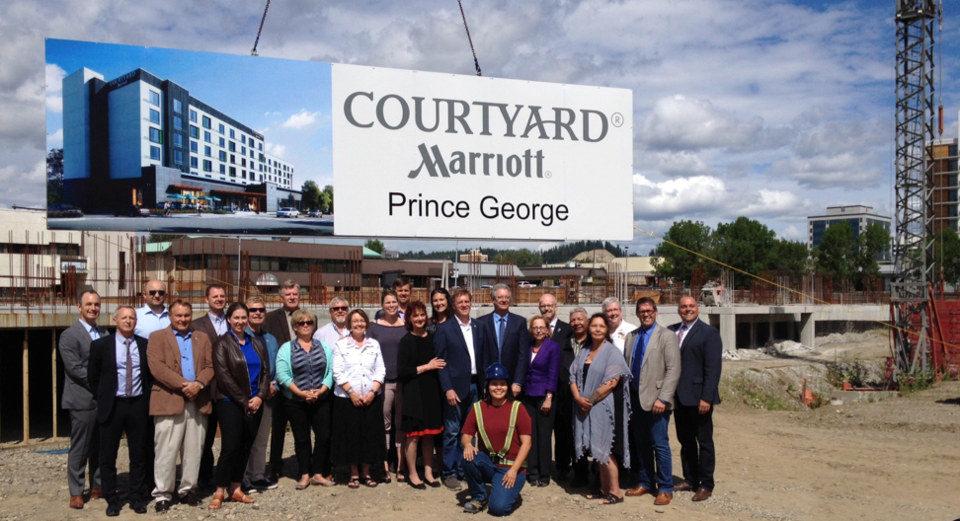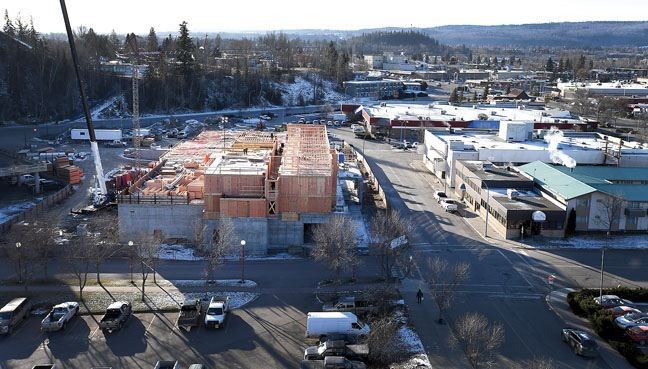Despite serious concerns raised about financial risk, the City of Prince George piled the majority of its downtown revitalization dollars into one hotel - and petitioned for even more economic development money for the project, documents obtained by The Citizen show.
The material, released by Northern Development Initiative Trust after a Freedom of Information request, show the city's efforts to offer more to the Marriott Courtyard hotel than was available in a $5 million fund the trust created to give up-front cash in the form of a repayable grant over 10 years.
After four revised funding requests, NDIT's board unanimously declined the city's call for extra funding into the program - the Revitalization Tax Exemption Early Benefit - which currently has about $3.4 million remaining. On Wednesday, Mayor Lyn Hall said Marriott developers have been offered $3.2 million and the city is seeking tax exemptions on the remaining value it had hoped to offer.
That calculation won't be finalized until the project is complete, but estimates show the value is more than $5 million, leaving the Marriott in a $1.8 million shortfall.
While NDIT has no control over how the city hands out revitalization funds, that didn't stop the trust from communicating its displeasure with the deal.
"Staff is concerned with the lack of diversity among the city's proposed RTE investments as well as the magnitude of funding being invested in a hotel project that already has a track record of failure and is the subject of media attention and public scrutiny," said a February backgrounder to the NDIT board.
The rest of the funds have been used on five local projects over the last four years, ranging from $71,190 to Northern Linen to $700,000 for the Royal Bank building facade renovations. The Marriott represents the bulk, taking 64 per cent of the revitalization fund.
"Staff are also concerned about the ability for the trust to recoup the funds from the hotel project should it fail financially a second time," the backgrounder said.

Until this year, the construction site was vacant and unfinished with concrete and rebar exposed to the elements. The plan for the site shifted over the years. In 2012, developer Rod McLeod said a 150 room full-service hotel would be completed by late 2013, but by October 2013, the goal had shifted to a $35-million four-star hotel under the Delta brand. In January 2015, Maryland-based Marriott International Inc. signed an agreement to buy the properties.
Later, PEG Development and Blue Diamond Capital, both based in Utah, were brought in as partners on the project. McLeod and the city officially unveiled the Marriott project in July.
Hall, city manager Kathleen Soltis and city planning and development general manager Ian Wells all said the money will be repaid.
"NDIT will be made whole," said Soltis. "There's no concern on the city's end about that."
The hotel is a cornerstone for the downtown, Hall said, where the city has long been focused on redevelopment and revitalization. And it would not have been developed without help from the incentive program, Soltis said.
"The hotel brings with it significant opportunities for other business in the community, another top-rated hotel in town is certainly a plus, provided us the opportunity to provide more rooms for larger conventions that were out there that perhaps in the past we couldn't because we didn't have the rooms we needed so it's just the overall development," said Hall, who also pointed to $125 million worth of building permits issued this year - the most since 2007.
The project is expected to create 200,000 hours of construction work and employ 40 people once completed.
Flip through a timeline of the project's history:
The documents obtained by The Citizen show back-and-forth negotiations as the city argued the fund should be replenished and tried to offer alternatives so it could get the additional funding. The Citizen made the same request to the city for documents related to Marriott negotiations. The deadline for their release is next week.
At first, the city promised it wouldn't ask for any further funds for five years, then doubled the offer to 10 years, a time frame that covers more than two future city council mandates.
Soltis said that's business as usual for both city administration and council.
"Council is an ongoing body and council is always making promises," she said. "They commit to various capital projects and such that take place over 10 years, 15 years, 20 years. We take on 20-year debt."
"Council makes decisions day in and day out and if future councils choose to change that, then it will but that's their call," said Hall, who later stressed that would only impact city requests and not other organizations or non-profits in Prince George.
NDIT saw the offer in a different light.
A February briefing note cautioned the 10-year promise would affect on average more than $200,000 in annual grants requested by the city as well as other grant-writing and business facade programs.
“This new agreement would mean the city would not apply to the trust for funding to support any of its infrastructures, buildings or economic development initiatives for a decade, impacting the ability of a future city council to access funds from the trust for new priorities," the document said.
Other councils have not put forward this approach, said NDIT's new chief executive officer.
"We have never seen anything like that before in terms of that offering and certainly one of our questions around that would be ... how does that impact other potential projects that could qualify for funding either from the municipality or non-profits and First Nations communities?" asked Joel McKay, who said the fund was a "one-time, one-off program" to revitalize downtown.
When it became clear the city wouldn't get extra funds, Soltis wrote McLeod of River City Hotel Inc. and Cameron Gunter of PEG Development to say the city would grant a 10-year tax exemption on the remaining portion.
Save for that one letter, the documents from NDIT don't show communication between the city and the developer.
By July, when NDIT saw the April offer, former CEO Janine North sent a sharp note to the city to stress the terms of the agreement that specifically forbid offering the two perks at once.
She also told her staff that they should not attend the July Marriott unveiling because it had yet to hear back from the city whether it had spoken to the developers and had not yet resolved "the issue."
"We remain concerned that the developer is investing in construction under a mistaken impression that NDIT can facilitate a Revitalization Tax Exemption early benefit, while the city provides a tax exemption over the same property," wrote North in her letter to the city.
A week later, Hall confirmed he'd spoken with the developers about the rules preventing tax exemption on top of the cash grant and Hall repeated Wednesday developers weren't investing under that mistaken impression.
But the city is still requesting a rule change. It's working on a proposal that will first go before city council and then the NDIT board for consideration.
Wells said the developer still has the option to decline the early benefit and go forward with a 10-year tax exemption.
The way the RTE early benefit program is set up is the money from the trust goes to the city, which passes it on to the developer.
The developer starts repaying that loan back through the city, which sends a portion of the cash to the trust from taxes collected each year, which wouldn't be collected in whole if a project had some form of a 10-year tax exemption.
"The reason why that piece in the contract is in there specifically is to help ensure the trust is paid back by the developer's taxes," explained McKay.
It's a different approach that adds value, McKay said, because the trust could offer payment up front, whereas the tax exemption offers that break over a decade.
"The goal being that that lump sum payment then incentivizes the developer to invest in downtown versus another part of the city because they're getting those funds up front."
Despite the disagreement over disbursement, today both the city and NDIT say they have a strong working relationship.
"NDIT have a role to play just as we do," said Hall.
"Really at the end of the day we want them to be a partner with us, just like every other organization in the community we do business with. I think this relationship is strong and we've got a long history with NDIT."



